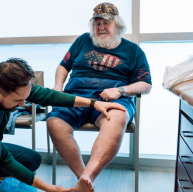Superior Sprained Ankle Treatment & Care
A sprained ankle can be both painful and frustrating, often leading to swelling, bruising, and difficulty walking. We know how uncomfortable an ankle twist or turned ankle can feel, and we’re here to help. Our team specializes in sprained ankle treatment designed to reduce inflammation, support healing, and restore stability, so you can get back to your normal life free from ankle pain.
Superior Sprained Ankle Treatment & Care

- Advanced Treatment Options
- Patient-Centric Approach
- Comprehensive Care Network
Understanding Sprained Ankles: Acute Care & Prevention

Understanding Sprained Ankles: Acute Care & Prevention
How We Help Prevent and Effectively Treat Ankle Sprains
If you do sprain an ankle, our treatment program is designed to offer relief, promote healing, and restore confidence in your ankle movement. Our focus is on both immediate comfort and strengthening to help you return to activities without fear of re-injury. We offer a range of effective therapies to make your recovery as smooth as possible, including:
- Thorough evaluation and diagnosis
- Physical therapy and strengthening exercises
- Advanced care for more severe injuries
- Ankle bracing and supportive footwear
- Gradual return-to-activity and guidance
This comprehensive treatment process provides effective relief for your sprained ankle injury and sustained recovery to help you regain strength in your ankle joint and get back to the activities you enjoy the most. Contact our team today or schedule an appointment online to get on the road to recovery from debilitating sprained ankle pain.
Here’s What Patients Are Saying About Our Care



4.89 Average Online Review Score



Common Causes of Ankle Sprains
A sprained ankle usually happens when the foot lands awkwardly, causing an ankle twist or turned ankle to bend beyond its normal range. This sudden movement can overstretch or tear the ligaments that support the ankle joint. Sports and activities that involve quick changes in direction, such as basketball or soccer, are common causes. Uneven surfaces, such as hiking trails, or wearing shoes that don’t provide adequate support can also increase the risk of an ankle sprain.
People with a history of ankle sprains are more likely to experience a sprained ankle again, as weakened ligaments can lead to chronic ankle instability. Our expert team of podiatrists at StrideCare can recognize these risk factors and create a customized treatment plan focused on healing and future injury prevention.
Signs & Symptoms You Might Have an Ankle Fracture
- Swelling around the ankle
- Bruising and discoloration
- Pain when bearing weight, from mild to severe
- Chronic ankle instability
- Limited mobility or difficulty moving the ankle
If any of these symptoms describe your ankle injury, our team of foot and ankle specialists at StrideCare address your sprained ankle pain and support you in comprehensive healing to help protect against future ankle sprains.
Find a Podiatrist for Sprained Ankle Treatment Near You
Have you suffered an injury resulting in a twisted, swollen, and potentially sprained ankle joint?
Enter your zip code below to find a StrideCare podiatrist near you and get a personalized assessment and treatment plan today.
Frequently Asked Questions about Ankle Sprains
Sprained ankle vs broken ankle: What’s the difference?
A sprained ankle involves overstretched or torn ligaments, while a broken ankle means a fracture in one or more of the ankle bones. A thorough exam and imaging can help determine the type of injury.
How long does it take for a sprained ankle to heal?
Healing time varies but typically ranges from a few weeks for mild sprains to several months for more severe cases. Following a treatment plan can help speed up recovery.
Can I walk on a sprained ankle?
Depending on the severity, you may need to avoid putting weight on the injured ankle initially. A healthcare provider can guide you on when it’s safe to begin weight-bearing again.


